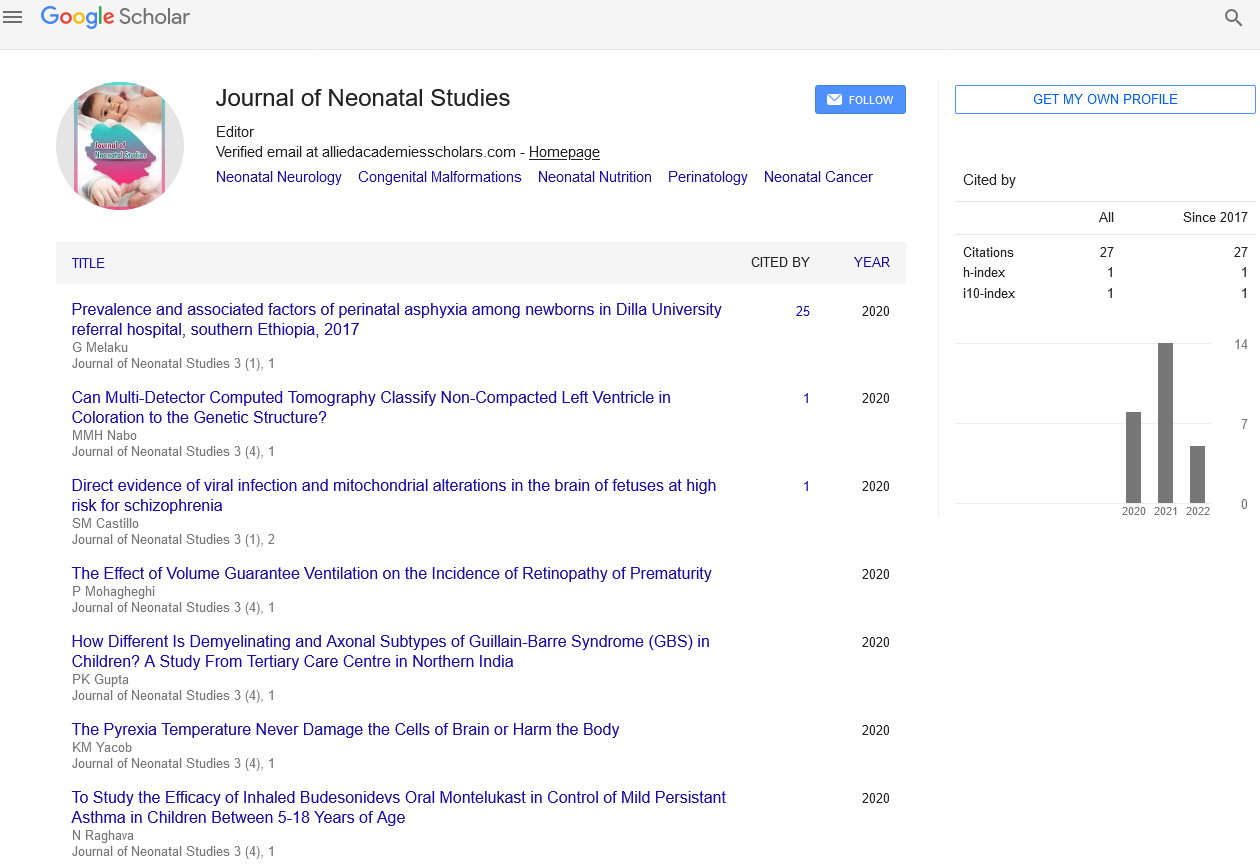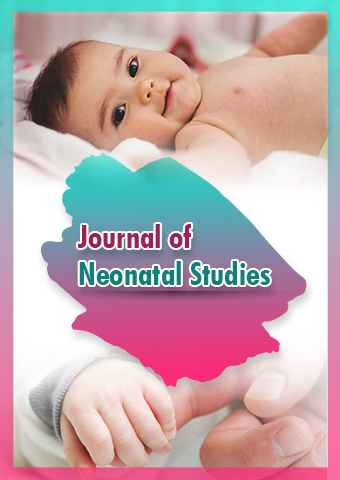Perspective - Journal of Neonatal Studies (2024) Volume 7, Issue 6
Breastfeeding: How to Establish a Good Milk Supply for Neonates
- Corresponding Author:
- Kamilah Nailah
Department of Pediatrics, Universitas Sumatera Utara, Indonesia
E-mail: Kamilah4@usu.ac.id
Received: 04-Nov-2024, Manuscript No. JNS-24-150540; Editor assigned: 06-Nov-2024, PreQC No. JNS-24-150540 (PQ); Reviewed: 20-Nov-2024, QC No. JNS-24-150540; Revised: 24-Dec-2024, Manuscript No. JNS-24-150540 (R); Published: 31-Dec-2024, DOI: 10.37532/ JNS.2024.7(6).297-299
Introduction
Breastfeeding is a natural and effective way to provide infants with the nutrients they need for healthy growth and development. However, establishing a good milk supply can be challenging for some new mothers. Understanding the factors that influence milk production and implementing effective breastfeeding practices can help ensure a sufficient milk supply for neonates. This article explores the importance of breastfeeding, factors affecting milk supply, and practical tips for establishing and maintaining a good milk supply.
Description
The importance of breastfeeding
Breastfeeding offers numerous benefits for both the mother and the baby. Breast milk provides the perfect balance of nutrients, antibodies, and hormones that support the baby’s immune system and overall development. Some of the key benefits of breastfeeding include:
Nutritional excellence: Breast milk contains the ideal balance of proteins, fats, vitamins, and minerals that support optimal growth and development.
Immune support: Breast milk is rich in antibodies and immune factors that protect the baby from infections and illnesses.
Bonding: Breastfeeding promotes skin-to-skin contact and emotional bonding between the mother and the baby.
Digestive health: Breast milk is easily digestible and helps establish a healthy gut microbiome in the baby.
Long-term health benefits: Breastfeeding has been associated with a reduced risk of chronic conditions such as obesity, diabetes, and certain allergies later in life.
Factors affecting milk supply
Several factors can influence a mother’s milk supply. Understanding these factors can help address potential challenges and promote successful breastfeeding:
Frequency of feeding: The more frequently the baby nurses, the more milk the mother’s body will produce. Regular breastfeeding stimulates milk production through the principle of supply and demand.
Effective latch: A proper latch ensures that the baby effectively removes milk from the breast, stimulating milk production. A shallow or ineffective latch can lead to inadequate milk removal and reduced supply.
Maternal health and nutrition: The mother’s overall health and nutritional status can impact milk production. A well-balanced diet, adequate hydration, and managing stress are important for maintaining a good milk supply.
Hormonal factors: Hormones such as prolactin and oxytocin play a crucial role in milk production and letdown. Factors that affect hormone levels, such as stress or certain medications, can impact milk supply.
Practical tips for establishing a good milk supply
Early initiation of breastfeeding: Start breastfeeding as soon as possible after birth, ideally within the first hour. Early initiation helps establish a good milk supply and promotes bonding.
Frequent feeding: Nurse the baby on demand, aiming for 8-12 feedings in a 24-hour period. Frequent feeding stimulates milk production and ensures the baby receives enough nourishment.
Effective latch: Ensure that the baby has a deep and comfortable latch. The baby’s mouth should cover a large portion of the areola, not just the nipple. Seek guidance from a lactation consultant if needed.
Skin-to-skin contact: Practice skin-to-skin contact with the baby. This promotes bonding, stimulates milk production, and encourages the baby to nurse more frequently.
Stay hydrated: Drink plenty of fluids to stay hydrated. Water, herbal teas, and milk are good choices. Avoid excessive caffeine and alcohol, as they can affect milk production.
Healthy diet: Consume a well-balanced diet rich in fruits, vegetables, whole grains, lean proteins, and healthy fats. Certain foods, such as oats, fenugreek, and fennel, are believed to support milk production.
Rest and relaxation: Adequate rest and managing stress are important for maintaining a good milk supply. Practice relaxation techniques, such as deep breathing or meditation, to reduce stress levels.
Common challenges and solutions
Breastfeeding can come with its challenges. Here are some common issues and solutions to help maintain a good milk supply:
Sore nipples: Sore nipples can result from an improper latch or frequent feeding. Ensure the baby has a proper latch and use lanolin-based nipple cream to soothe sore nipples. Allow nipples to air dry after feeding.
Engorgement: Engorgement occurs when the breasts become overly full and uncomfortable. Frequent breastfeeding, gentle breast massage, and using warm compresses before feeding can help alleviate engorgement.
Low milk supply: If milk supply is low, consider increasing the frequency of feedings or pumping sessions. Ensure the baby has an effective latch and consult a lactation consultant for personalized advice.
Mastitis: Mastitis is a breast infection that can cause pain, redness, and flu-like symptoms. Continue breastfeeding, apply warm compresses, and seek medical treatment if necessary.
Case studies and success stories
Several case studies highlight the importance of proper breastfeeding techniques and support in establishing a good milk supply:
Case study 1: A first-time mother struggled with low milk supply due to an improper latch. With the guidance of a lactation consultant, she improved her baby’s latch and increased the frequency of feedings. Within a few weeks, her milk supplies increased, and her baby gained weight steadily.
Case study 2: A mother of twins faced challenges in maintaining an adequate milk supply for both babies. She implemented frequent feeding sessions, used a double breast pump, and practiced skin-to-skin contact. With support from her healthcare provider, she successfully established a good milk supply and exclusively breastfed her twins.
Case study 3: A preterm infant in the NICU required tube feeding initially. The mother used a breast pump to stimulate milk production and provided expressed breast milk for her baby. As the baby grew stronger, direct breastfeeding was introduced, and the mother continued to pump to maintain supply. The baby’s growth and development thrived with the mother’s milk.
Research and future directions
Ongoing research in lactation science continues to explore ways to support breastfeeding mothers and enhance milk production. Some areas of focus include:
Lactation supplements: Investigating the efficacy and safety of herbal supplements and galactagogues in promoting milk production.
Breastfeeding education: Developing comprehensive breastfeeding education programs for healthcare providers and parents to ensure consistent support and guidance.
Technology in lactation: Advancing breast pump technology and developing wearable devices to monitor milk production and support lactating mothers.
Community support: Implementing community-based breastfeeding support programs and peer counseling to promote breastfeeding and address challenges.
Conclusion
Neonatal nursing is a specialized field dedicated to providing comprehensive care for newborn infants during their initial days of life. This crucial period requires skilled nursing intervention to support the transition from intrauterine to extrauterine life and promote the health and well-being of neonates. In this article, we will explore essential nursing guidelines for neonates, covering various aspects of care, from assessment and monitoring to feeding and developmental support.

